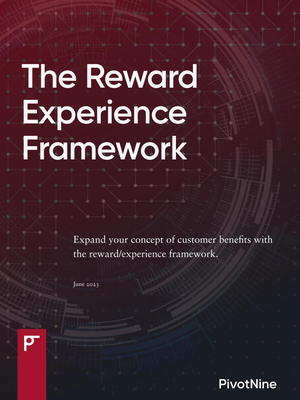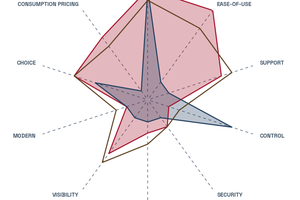The Reward/Experience Framework

The Reward/Experience Framework
Technology companies tend to focus on a narrow set of benefits while customers have a much richer set of benefits that they value. Actual human beings are not purely rational creatures, and we should take this into consideration when making marketing decisions.
By expanding the range of benefits that we consider worthwhile, we can open up opportunities to speak to customers in ways that have been previously ignored.
Expanding our thinking can also provide strategic advantage. While our competitors continue to talk only about a small range of possible benefits, we are able to communicate with customers in ways that competitors simply don't think about, let alone act on. We no longer need to compete head on, but can out-manoeuvre competitors by showing up where they are not.
| Rational | Sensory | Social | Ego | |
|---|---|---|---|---|
| Result-of-use | I can use this drill to make a hole. | This perfume makes me smell nice. | I can see my friends by catching the train to the city. | It was smart of me to use this toilet cleaner. |
| Product-in-use | This pen helps me write a letter. | This cake tastes great. | People think I’m cool when I wear these jeans. | I feel great wearing this shirt. |
| Incidental-to-use | I am sheltered from the rain in this restaurant. | This book smells nice. | I will have more friends if my house is tidy. | I like owning a Ferrari. |
Table: The reward/experience framework.
In this framework there are four major reward categories:
- Rational
- Sensory
- Social
- Ego Satisfaction
and three major experience categories:
- Result-of-use
- Product-in-use
- Incidental-to-use
We step through each of the categories in detail below.
The Categories in Detail
The two axes meet to create a combined reward/experience context for how product rewards are experienced by customers.
The Reward Categories
Rational
Rational rewards are objectively verifiable. They can be justified using logical reasoning grounded in objective facts. They are often the easiest to identify because of their relative visibility, and are generally easier to measure.
Rational rewards appeal to technology focused people because they tend to think of themselves as more rational than average humans. This bias leads them to undervalue other kinds of rewards that customers may value.
Sensory
Sensory rewards may seem superfluous for technical products. Consider that the aesthetics of product design, such as the user-experience of dashboards or apps, are inherently sensory and are worth thinking about in those terms.
The way it feels for a developer to use an API, the aesthetic elegance of a visual metaphor, or the relative complexity of a command-line interface can all be considered in sensory terms.
Social
Humans are social creatures. We like to communicate and collaborate with each other. Technology often provides social benefits, and not just technologies focused on socialising or communication.
Sometimes there may be clear rational benefits of a particular technology choice, but these can be outweighed by the social benefits of a different technology. Network effects are an inherently social phenomenon, and they can be quite powerful.
Ego Satisfaction
Never underestimate the ability of an individual's ego to drive their behaviour.
Ego satisfaction benefits can overcome many technical or sensory flaws in a product. Self-belief is a powerful driver, which we can use to our benefit, or ignore at our peril.
Ego benefits are frequently the hardest to identify and measure because they largely exist inside our minds. This is further complicated by the degree to which we like to fool ourselves about how much our ego drives our decisions. Customers may lie—not maliciously or even deliberately—about ego benefits.
Fooling ourselves about our own true motivations is all too easy.
The Experience Categories
Result-of-use
A product result-of-use benefit is what happens as a consequence of using the product. It is the outcome.
A customer experiences this benefit after they have used the product successfully. The customer can stop using the product, and the benefit will still be there.
Product-in-use
A product-in-use benefit is a benefit experienced while using the product.
Some benefits can only be experienced while a product is actively being used. They don't stick around as an outcome after the product is used (those are result-of-use benefits).
Incidental-to-use
Some benefits are not directly related to the product being used, but the customers experiences some kind of benefit anyway.
Often these benefits are unintentional side-effects of product design, but they don't always have to be.
Using the Framework
This framework, like all frameworks, is a way to structure our thinking and help us to consider things we might have otherwise overlooked. It is not the only way to view the world, and we shouldn't become overly reliant on it or use it exclusively.
Use this framework to force yourself to consider benefits that are not rational result-of-use or rational product-in-use benefits. We may dismiss certain benefits as not applying in our particular case, but we should at least consider them.
Use Every Category
Rational rewards appeal to technology focused people because they tend to think of themselves as more rational than average humans. This bias leads them to undervalue other kinds of rewards that customers may value.
Rational rewards do exist, and ignoring them would be a mistake. However, over-valuing them, or ignoring other reward categories altogether, would also be a mistake. Instead, look carefully at other potential reward types and investigate if customers value them or not.
Thinking about all the different ways customer benefits can occur can help us to design better products. It can also encourage us to highlight benefits that customers value but that we would have otherwise overlooked. We may already be providing many benefits that we simply don't talk about.
Combining Categories
It can be useful to communicate a benefit using multiple categories, such as both rational result-of-use (I use this drill to make a hole) and ego satisfaction incidental-to-use (I am smart to use a drill to make this hole instead of trying to use a spoon).
There are many possible combinations, and working through them systematically may lead to a sudden insight that we would not have otherwise considered.
If nothing else, we will have at least satisfied ourselves that we looked for other benefits and did not find any. At least we tried, and can have greater confidence that we did not overlook something obvious that could have helped us.


